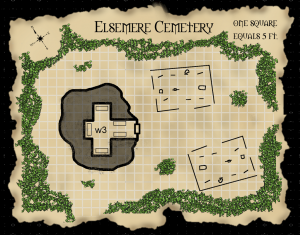Junction
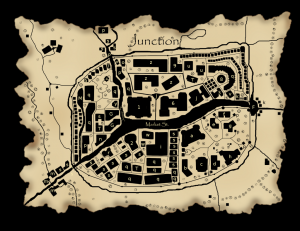 Medium Town: Conventional; AL LN; 10,000 gp limit; Assets 2,000,000 gp; Population 3,000; Mixed (95% human, 2% halfling, 1% elf, 1% gnome, 1% dwarf).
Medium Town: Conventional; AL LN; 10,000 gp limit; Assets 2,000,000 gp; Population 3,000; Mixed (95% human, 2% halfling, 1% elf, 1% gnome, 1% dwarf).
Junction lies along the road from the Jæruel to the Cyrűk Mountains and into Northbay. The walled town has 3,000 inhabitants, many of whom moved to the town relatively recently. The town is still expanding along with its walls, so there is much housing still under construction along the edges of town. Junction enjoys a relatively high standard of living, as there is much abundant produce and rolling fields for cattle to graze upon in the area, and nice stone that is mined in Alabaster to the north. Fish stream in from the coastal town of Uppwint the southeast.
Junction serves as the main hub of the trade route from the Cyrűk Mountains to the Jæruel, and part of its wealth has developed through the high tariffs imposed by the local Jæruel officials. These official live in the southeast of town in a gated community.
Architecture
The buildings in Junction are mostly made of wood. Much of the mansions in the wealthy quarter have stone foundations and parts of walls made of stone. The city hall and older buildings along Market St. are made of stone. Parts of the city walls are stone — 5 feet every 10 foot section of wall. Much of this stone was brought in from Alabaster to the north, though some was quarried a few miles northeast of Junction.
Layout
Market Street runs east-west in the center of the walled city. Local merchants without a permanent shop set up each morning along this thoroughfare which is much wider than the streets in the rest of the town. Guard towers are prominent features in this town of local militia. All the troops report to the Jæruel who very clearly run the town.
Justice Street runs north-south from Market St. to the North Gate. The Temple of Justice sits at the corner of Justice and Market. Thieves are usually sent to the temple to repent before being tried.
The southeast quadrant of the town is the wealthy residential area known as Sunnlunt. Eight large mansions occupy the space, each with its own stables. Shrines line the main roads into the quadrant, filled with scenes painted from humanized images of Garl Glittergold.
The northeast is home to the arena. Many people live in this part of town, including warriors and small-time merchants who sell wares in and around the arena during events. There is also a temple to the god of war along Market St. To the east end of Market St., East Gate overlooks Fish Square, where the fresh catch is brought in from Uppwint and other, smaller fishing villages along the coast.
The north central part of town is known as the Jæruel district. This is where the city hall, the temple of justice and the Jæruel administrative buildings can be found. The quarters in this part of town are equivalent to decent merchant homes. Guards stationed at the North Gate keep watch over Pork Square, home of the famous pig auctions.
The southwest district is known as the Merchant quarter, named because it is home to many successful merchants, as well as a temple and the Climbing Rose Inn. The homes are fairly well cared for and there is only moderate crime. The West Gate overlooks Apple Square, where much produce enters the city.
If not for the troops stationed in this part of town, the northwest would perhaps be a sketchy part of town. In addition, given the walled nature of the city, crime is not as rampant as one would expect for a population of nearly 3,000, over 4,000 on the heavier trading days, and 5,000 during the first market days of the lunar cycle.
Map Key
Religious:
1 Justice Temple of Hieroneous
2 Peace Temple of Fharlanghn
3 War Temple to Kord
4 Druid Temple to Ehlonna
5 Various Shrines
Civic:
6 Town Hall
7 Trade Winds Oak (south side of Town Hall)
8 Arena
9 Merchant Museum
Mansions:
a Luxord Manor
b Dwenton Manor
c Tynold Manor
d Swansyd Manor
e Jarlsbyd Manor
f Hox Manor
g Antol Manor
h Tanebrux Manor
Other:
A Apple Square
F Fish Square
G Garrisons
i Market Inn
j Jæruel
J Jæruel Square
k Kiosks
m Mills
M Mercantile Square
n Inn
o The Three ‘N’ Blankets
p Stables
P Pork Square
q Residences
r The Climbing Rose
s Shops
t Towers
T Small Taverns
u Blacksmiths
v Warrior Guild
w Mage Houses
x Training Grounds
y Magic Shop
z Jæruel Quarters
The buildings outside the town walls are barns and farmhouses. On the north end of the town are pig stalls and to the northwest is Eggelt Farms, where chickens are raised and vegetables grown.
Persona
Junction is a town of many merchants. They live decent lives selling their wares and keeping the populace well fed. Farmers come to town and sell produce most days of the week, and with the constant influx of travellers, the inns remain at least half full, and the visitors meander about the markets in the morning hours before setting off for adventure. When the weather is favorable, there is much music and dance in the streets, but when it rains, the people are glum, moping about in the taverns and waiting out the weather.
There is a slight feeling of inequity among the poorer workers in town. When the ruling Jæruel officials parade along Market St. or show themselves in the arena, the people eye them suspiciously. Foreigners are welcomed as long as they are strong warriors. The people of Junction can’t stand weakness — they’ve worked too hard to stand it.
Jæruel leaders administering Junction:
Tarrin Dwenton
Darrius Luxord
Felonious Hox
Mortimyr Swansyd
Lynus Tynold
These posts will follow.
Posted in Uncategorized and tagged Jæruel, Location, town by Stephen Hilderbrand with no comments yet.
Wastaru
Wastaru is the name of the western continent on most maps and globes of the world. This continent is analogous to the New World in our mythology.
Geography
The south end of Wastaru is characterized by a long tail of a peninsula, along which lie a string of active volcanoes. Cartographers have often noted the dragon-like shape to the land as they reach the end of the dot connecting the coastlines.
A central spine of geologically young mountains clusters in the center of the continent.
On the north end of the continent is a series of glacial islands. The water is cold, and travel by ship is often fraught with danger.
Bestiary
The creatures of the Wastaru (pronounced wa-STA-ru) differ from those of the Farghoal and other continents of the world. Loxodons replace elephants, tightly organized societies of prehistoric humans and demi-humans thrive, and in the vast subterranean passages, dark elves, deep gnomes, and twisted dwarves worship occult powers thought long dead and unimagined on other continents.
Orcs are replaced with gorks, a cross between gnolls and their pig-faced orc brethren. Gorks worship a dark power that gives them damage resistance, making them more fierce than their ancestors. A might-makes-right societal view means that only the most vicious survive kind enough to procreate. As such, the youngest gorks have an even stronger damage resistance.
Lizard men are represented by Sslahs. They are hunted down by gorks for use as meat, so they tend to stick to the deep swamps where they hatch, living off the small creatures there.
Hunders are more sinister than their normal kobold cousins, needing less sleep and having twice the appetite. They wander the surface at night and burrow into shallow caves or occupy hollow lava flows to escape the sunlight during the day.
In the gulf formed when the peninsula ripped off of the mainland. The water stays about 10 degrees warmer than the water out in the open oceans.
The Emerald Sea can be found off the southeast coast of the continent. The Litlos Islands can be found in the Emerald Sea.
Civilization
The southern peninsula and areas surrounding the Marsh Tides is occupied by three races of humans known as the Shal-shekti, the Kalah, and the Zhazune. These races vie for control of these lowlands.
(These three races will be detailed in a later post)
Other humans and races (seaworthy elves and dwarves) have colonized portions of the continent, though many of these have met with ill fates. There are remote colonies along the northern and eastern seaboards.
Posted in Uncategorized and tagged continent, Location, Wastaru by Stephen Hilderbrand with no comments yet.
Marsh Tides
Beware the tides of marsh!
This region in Wastaru is filled with mashlands and barrier waters. Looming overhead is a ring of volcanoes which constantly simmer, causing the water to heat up and the local bestiary to panic and stampede. The droopy trees in the marshlands extend out into the ocean about 1/2 mile off of the shore, wherein the water has a black hue and a tar-like consistency. There is death in those waters.
The marsh tides are the home of the kakataur, a prehistoric alligator/lizard/dinosaur beast. These creatures are very deadly, as they blend in to the wilderness and attack with monstrous fangs behind 1/2 ton frames.
The marsh tides are also the home of the slithe, a great serpent of the marsh. These creatures sneak up and then wrap their 20′ long, slender bodies around their prey, leaving them no hope of survival.
The tides rise and fall, leaving the area well ventilated and constantly altered. The paths through the marsh change with each tide, so humans rarely venture into this region, and almost never make it out alive.
(map to follow)
Posted in Region and tagged Location, marsh, Wastaru by Stephen Hilderbrand with no comments yet.
Emerald Sea
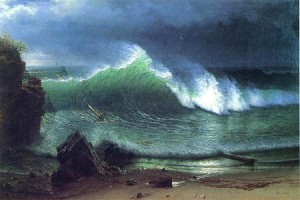 With Austin’s enduring twice our expected rainfall for the year (already in July!) we figured we should share an underwater treat.
With Austin’s enduring twice our expected rainfall for the year (already in July!) we figured we should share an underwater treat.
This green sea is set along the southeast coast of the continent of Wastaru. The warm waters teem with life of various sorts, including many species of jellyfish and anemone.
At the bottom of the Emerald Sea is an aquatic kingdom rimmed by a large coral reef, within which live many herds of coral horses. The kingdom is ruled by aquatic elves who are powerful masters of water and weather magic. The extensive royal family delegates different offices and fiefs to various sons, daughters, brothers, sisters, cousins, aunts and uncles in a complex and shifting balance of power. Their subjects include tritons and other merfolk from surrounding regions.
The volcanic activity and fault line that runs along the center of the sea have help formed the multiple small island chains which can be found in the Emerald Sea, including the Lítlos Islands, the Recant Islands, the Anatatu, and Gavaan Islands. A map will show them in relation, and posts will follow which will detail these each in time.
Posted in Uncategorized and tagged Location, ocean or sea by Stephen Hilderbrand with no comments yet.
Elsemere Wood Cemetery
These encounters will be appearing in the upcoming adventure The Horror of the Old Ones. In the meantime, feel free to drop them into your game wherever you need a creepy old cemetery. And who doesn’t need a monster-filled cemetery?
Cemetery (EL 5)
creatures: begotten of the old one (1): HP: 70 A begotten of the old ones lives here. Born a child of the sea to one of the families in Elsemere, he grew up as a shut-in, hidden by his parents from the rest of the village. Upon his patents death he was discovered and driven out of the village. The maddening dreams of the wood have made him quite mad, and now he will viciously attack anyone entering the cemetery.
Mausoleum (EL 9)
Inside the crypt there are four carved stone coffins. Two of the sarcophagus lids have been pushed open by tree roots, and an intricate brass sword stand lies toppled over at the head of one of them.
Several shriveled corpses with various armors and dusty equipment lie scattered on the ground here.
Anyone approaching within 30 ft of the death root becomes subject to it’s fatiguing radiance and must succeed on a DC 15 Fortitude save or become fatigued.
Investigating the bodies, a DC 20 heal or spot check, reveals that they were crushed and drained of blood through many tiny wounds.
creatures: death root (1): HP: 63 A death root – the tree – is on top and inside the crypt and will attack anyone entering once they have come inside.
treasure: Here there are several dead adventurers and their gear, plus loot from the sarcophagus. All together it amounts to 1,200 gold, a smooth marble scepter worth 600gp, an intricate brass sword-stand worth 90gp, an arcane scroll containing: gentle repose (lvl 3, cast 5), sleep (lvl 1, cast 1), and undetectable alignment (lvl 1, cast 1) (450gp value). Additionally there is a +1 longsword (2,315gp) and another arcane scroll containing: feather fall (lvl 1, cast 1), bull’s strength (lvl 2, cast 3) and glitterdust (lvl 2, cast 3) (150gp) (325gp value).
Posted in 3rd edition Dungeons & Dragons / d20 fantasy / Pathfinder, Encounter and tagged Elsemere Wood, Horror of the Old Ones, Location by Adam A. Thompson with no comments yet.
The Ten Princedoms
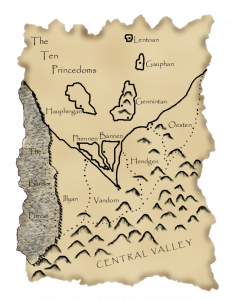 After King Vandor passed, his kingdom fell into the hands of his ten sons, none of whom agree on how the land should be run, so each have moved into separate residences and have defined ten states which they each administer. It’s a tenuous peace, but a peace nonetheless.
After King Vandor passed, his kingdom fell into the hands of his ten sons, none of whom agree on how the land should be run, so each have moved into separate residences and have defined ten states which they each administer. It’s a tenuous peace, but a peace nonetheless.
They have a sister, the youngest child, who has disappeared following Vandor’s death; rumor has it that she has become a witch in the neighboring Phyloctæte.
The mainland states and islands and their princely rulers, in order of birth (age in parens):
Vandorn is the central mainland part of the old Kingdom of Vandor. It is ruled by the sickly prince Hanik (38), the eldest son of Han. The Shankil and Dromgul Rivers come together just to the east of the city of Hanton.
Oesten is the easternmost mainland part of the Ten Princedoms. It has a bit of a frontier feel to it, which Ernik (36) hopes to take advantage of. He is trying to move the border east into unclaimed lands.
Hendgen is nestled between Vandorn and Oesten. Tanith (33) runs this state from Edige, the city over the river of the same name that runs from hills of still the same name.
Illyan is the westernmost mainland state. On the western edge, the Border Forest serves as a buffer from the Phyloctæte, a strange land of unexplained magics. Kres (31) has gained a lot of popularity throughout the Princedoms by keeping the military strong and the border protected.
The islands:
Gennintan is the rocky island north of the mainland. It is administered out of the west-central city of Gennt by the fifth child, Pan (29). The south end of the island is full of natural resources, and the north end of the island is protected to the point of being only partially explored.
Gauphan is the island north of Gennintan, ruled by Garles (27), who tries to steer clear of his elder brothers’ powermongering. He is still sometimes drawn into disputes, along with this younger brothers, but constantly complains about it and often withholds his support until the last minute, when he usually sides with the underdog.
Phennen is the west of the twin islands just north of Vandorn. Fain (25) lives in the old mage tower on the south end of the isle, with views of the twin isle and the mainland.
Bannen is the east of the twin islands just north of Vandorn. Klaran (23) lives in the castle which now bears his name on a hill overlooking the strait on the west end of the isle.
Hauphingan is the green isle to the northwest of other states, ruled by Hain (22). The verdant fields produce a sweet wine that is enjoyed throughout the Ten Pricedoms.
Trochu (also known as Lentoan) is a tiny island to the far north of the Ten Pricedoms, ruled by Launce (19). The mage Djander has been known to inhabit the island, and is possibly influencing the decisions of the young ruler.
Posted in Uncategorized and tagged Location, nation or organization by Stephen Hilderbrand with no comments yet.
The Phyloctæte
This empire was once ruled by a council of four powerful mages, who, in their lust for control, ended up waging war with one-another in a three month period which has been come to be known as the Four Mage War. Nestled in between three other human-controlled lands, their war bled over into neighboring lands, with mages flying through the air, wyrms and other creatures battling across the lands. This made the Phyloctæte a feared land in bard’s tales, and to this day, people fear the regime of the victor, Feryn Dyndle, who shares her human lineage with that of the elves. Some people have spread rumors that full-blooded elves from faraway lands had something to do with her success in wresting control of the Phyloctæte from the other, full-human mages.
At the end of the war, one of the mages was killed, another sought refuge in the Astral Plane, and the other surrendered to Feryn Dyndle.
To the northwest of the Phyloctæte, across the Windplains, lies the Kingdom of Altæa. King Harald Altæa has no patience for the war that has affected villages in his domain.
To the west, over the Mountains of Insor, lies the relatively peaceful, multi-racial democratic republic of Nelshun. The Phyloctæte has had few dealings with Nelshun, so it remains to be seen how the new ruler will be received.
To the south, the militaristic Republic of Esrun controls the vast plains of Yæns. Esrun has for years planned to move on the Phyloctæte, and now may be their chance, with the council at it’s weakest. Rumors have it that they have stepped up production of swords and spears, and have recently domesticated some Yæns horses, which make powerful mounts.
To the southeast, through the Border Forest, the Ten Princedoms have formed out of the old Kingdom of Vandor, following the death of King Vandor.
The people of the Phyloctæte have grown weary of the Four Mage War, and have welcomed the recent cease-fire. They are busy rebuilding the towns and villages that make up their nation. Many of them could care less who rules the land, as long as they are left to their arts, crafts, and other skilled trades. Many would like to reap the benefits of trading with the neighboring nations.
Meanwhile, Feryn Dyndle is installing her elven brethren as the ministers and administrators of the nation.
Posted in Region and tagged Location, nation or organization by Stephen Hilderbrand with no comments yet.
Lítlos Islands
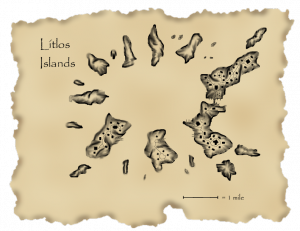 The island of Lítlos became the “islands of” when the volcano that originally formed the landmass erupted, killing all but a few of the original inhabitants, and leaving the crater that the present day islands surround. The largest of the islands has been reinhabited by those who were away on fishing and trade voyages on that fateful summer night. Though stone ruins dot the other islands, they have remained too unstable to support any new structures.
The island of Lítlos became the “islands of” when the volcano that originally formed the landmass erupted, killing all but a few of the original inhabitants, and leaving the crater that the present day islands surround. The largest of the islands has been reinhabited by those who were away on fishing and trade voyages on that fateful summer night. Though stone ruins dot the other islands, they have remained too unstable to support any new structures.
Feriño, the single town on the island shares its name with the island itself. The inhabitants, upon returning to find their homes destroyed and their people covered in ash or utterly disintegrated, decided upon the new name, their word for an aquatic creature resembling a phoenix. They built all their new structures using the lava rocks cast out by the volcanic eruption.
Most of the inhabitants believe that an aquatic fire dragon lives under the island. This leads to a nominal level of fear which surfaces in the dour tales woven by local bards, and mothers to their children.
The fashion on Feriño consists largely of togas and sandals, though the rulers of the land tend to dress in tunics and light trousers. The people mostly eat fish wrapped in seaweed, but the volcanic deposits that have enriched the soil have provided the islanders with a more rounded diet including fruit resembling plantains, pomegranates and dates. The government is largely hands-off, though the head of each household serves as part of a council that meets every month, and the eldest sons in each family serve in the navy. The people of Feriño barter with one-another in well-established tight-knit groups, so they do not willingly trade with outsiders unless offered an item they think is unique.
Posted in Uncategorized and tagged islands, Location by Stephen Hilderbrand with no comments yet.
The Jæruel
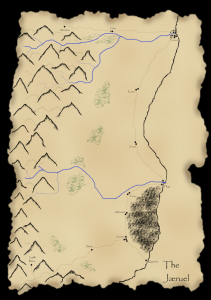 The Jæruel is a collection of fishing villages, mining towns, and tradespeople united under a merchant flag with three intersecting rings in the center over a brown backdrop with a sinister silver bend from the upper right to the lower left. The towns are officially independent, but they follow the lead provided by Tannen. The Jæruel merchant house which provides the name for the region is much more hierarchical, keeping strong hold over the markets in each of the towns, especially those higher up in the power structure. The only standing army is privately run by the merchants of the Jæruel.
The Jæruel is a collection of fishing villages, mining towns, and tradespeople united under a merchant flag with three intersecting rings in the center over a brown backdrop with a sinister silver bend from the upper right to the lower left. The towns are officially independent, but they follow the lead provided by Tannen. The Jæruel merchant house which provides the name for the region is much more hierarchical, keeping strong hold over the markets in each of the towns, especially those higher up in the power structure. The only standing army is privately run by the merchants of the Jæruel.
The towns and villages of Jæruel:
– Tannen – capital of Jæruel – bustling port town – what Onuago was built after – full of hides and wines other goods from all over the Jæruel (5,000)
– Piran Point – fishing and trading village (920)
– Flego – fishing village (400)
– Uppwint – named for the strong winds that bring fog and quick shifts in the weather to this quaint fishing village (200)
– Trover – fishing town (400)
– Alabaster – inland named for the stone mined from its cliffs (500)
– Junction – a “middle man’s” town at the intersection of trade routes (3,000)
– Himas – a stop on the path of produce to market in Junction (200)
– Franti – wine production, source of Franti grapes (600)
– Furton – wine production, source of Furton grapes, also furs all sent to Tannen (800)
– Ches (pronounced Shez) – fresh water fishing along a broad bend in the river (400)
– Westfort – a fort-like outpost in the mountains to the west of Tannen and Ches that provides hides and timber (200)
Small settlements are developing in the lands to the west of Franti and Furton, but they have not taken significant shape. Some of them have met with ruin due to various invaders — bandits, goblins, and even nefarious pixies getting in on the raiding action.
Posted in Region and tagged Jæruel, Location by Stephen Hilderbrand with no comments yet.
Ettin Lands
At the southern end of the Cyrűk mountains, a strain of ettin have made their home for multiple generations. These two-faced creatures often end up meeting their fate when one of their brethren challenges them to a duel to the death over some misunderstanding.
The Ettin Lands are a series of three tall hills surrounded by the neighboring peaks. Within these borders, ettin law reign supreme, that of might makes right. This way of life has been passed down through ettin culture, a mismatch of orc, giant, and various other mythologies and beliefs. It seems they are continually confused, perhaps due to their multiple heads, which often do not agree. Ettin (especially from this isolated region) have been known to argue with their own heads, sometimes leading to the two halves of the body pummeling the other to the ground. What is strange is watching them go at it — the right head controls the left side of the body, and vice versa, so the opposing blows must cross one-another in order to contact the intended targets.
Occasionally an ettin will travel outside of these borders into lands inhabited by humans or others of their ilk, but they have largely stuck to this region because of the plentiful supply of large game to hunt. In the neighboring Ettal valley, the meat is much leaner and quicker, making for too challenging a hunt, a major deterrent to this lazy species.
Still, they have been known to hunt men for sport. That is, when they can get along long enough to keep organized.
Recently, the ettin have been haunted by their own zombies, who roam the mountainsides at night in search of brains… ettin technically have two per body, making them even tastier prey to these zombies.
Posted in Region and tagged Location, Northbay by Stephen Hilderbrand with no comments yet.
